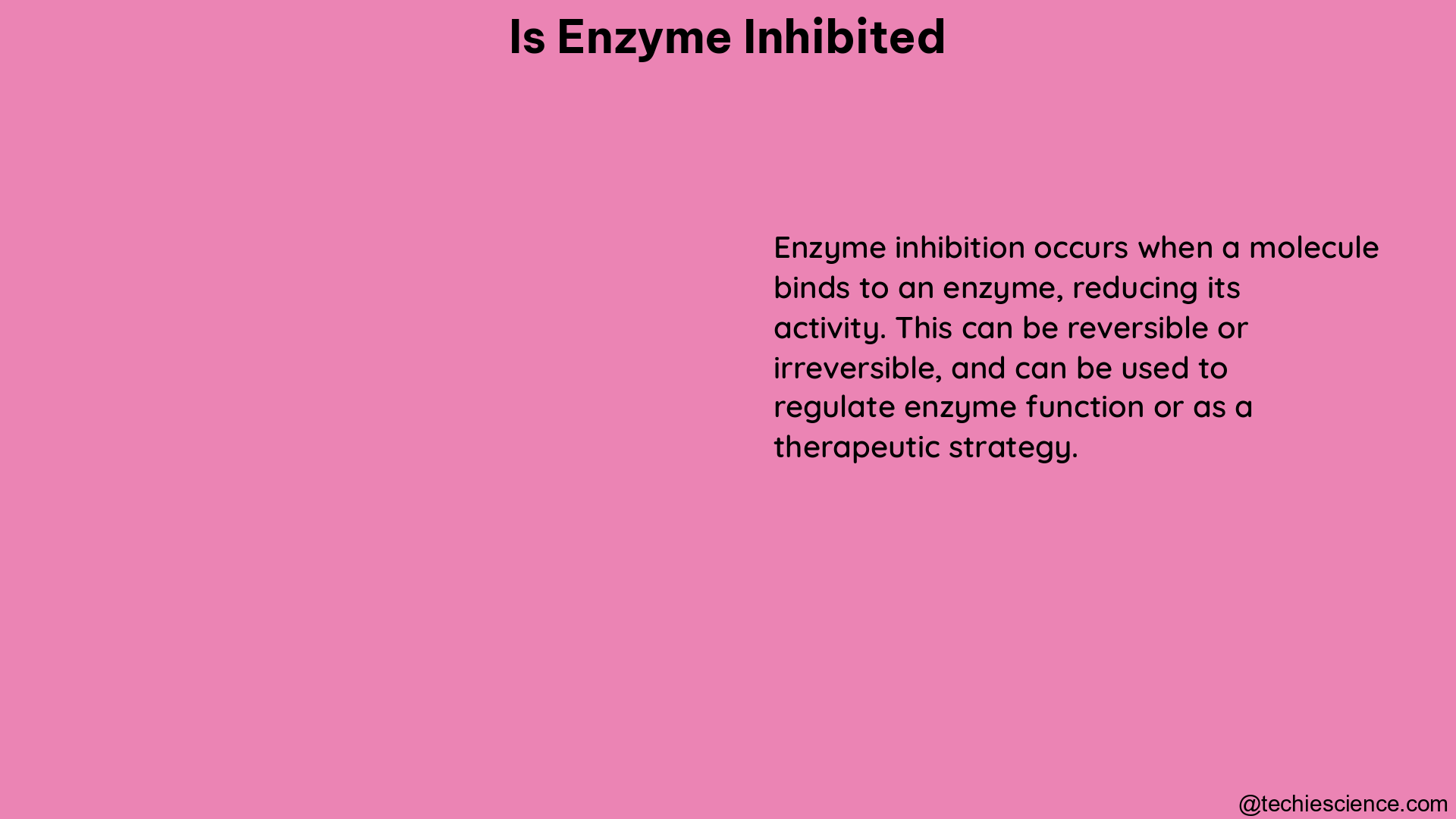Enzyme inhibition is a critical process in biology and medicine, as many drugs exert their effects through this mechanism. Understanding the intricacies of enzyme inhibition is essential for developing effective therapeutic interventions and optimizing drug design. This comprehensive guide delves into the various aspects of enzyme inhibition, providing a detailed exploration of the topic.
Quantifying Enzyme Inhibition: The IC50 Value
The IC50 value is a widely used metric for quantifying enzyme inhibition. It represents the concentration of an inhibitor required to reduce the enzyme activity by 50%. This parameter is valuable for comparing the potency of different inhibitors, as it allows for a standardized assessment of their effectiveness.
However, the IC50 value has its limitations, particularly when comparing inhibitors of enzymes with different Michaelis-Menten constants (Km). The Km value reflects the affinity of an enzyme for its substrate, and it can significantly impact the interpretation of the IC50 value. To accurately determine the IC50 of a reversible inhibitor, the substrate concentration should be sub-saturating, ensuring that there is free enzyme available for binding either the inhibitor or the substrate.
Modes of Enzyme Inhibition

Enzyme inhibition can be classified into two main categories: reversible and irreversible inhibition.
Reversible Inhibition
Reversible inhibition occurs when the inhibitor binds non-covalently to the enzyme, forming a reversible enzyme-inhibitor complex. This type of inhibition is typically characterized by a rapid and readily reversible interaction between the inhibitor and the enzyme. The IC50 value for reversible inhibitors can be influenced by the substrate concentration, as mentioned earlier.
Irreversible Inhibition
Irreversible inhibition involves the formation of a covalent bond between the inhibitor and the enzyme. This type of inhibition is generally more potent and longer-lasting than reversible inhibition. However, it can also lead to unwanted side effects due to the irreversible modification of the enzyme.
Multi-Target-Directed Ligands (MTDLs)
Incorporating multiple functionalities into a single molecule to create MTDLs requires careful assessment to ensure that the specific target effects are not significantly altered and that the kinetic behavior remains favorable. This is particularly important when developing MTDLs that combine monoamine oxidase (MAO) and cholinesterase (ChE) inhibitory functions, as these enzymes have different substrate specificities and kinetic properties.
Enzyme Inactivation
Enzyme inactivation can also be caused by physical or chemical factors, such as temperature, pH, or denaturants. These factors can lead to aggregation, dissociation into subunits, or denaturation of the enzyme, ultimately resulting in its inactivation.
Factors Affecting Enzyme Inhibition
Several factors can influence the extent and effectiveness of enzyme inhibition, including:
- Substrate Concentration: As mentioned earlier, the substrate concentration can significantly impact the interpretation of the IC50 value for reversible inhibitors.
- Enzyme Kinetics: The kinetic properties of the enzyme, such as the Michaelis-Menten constant (Km) and the maximum velocity (Vmax), can affect the inhibitor’s potency and the observed inhibition.
- Inhibitor Binding Affinity: The binding affinity of the inhibitor to the enzyme, as measured by the dissociation constant (Kd), is a crucial factor in determining the inhibitor’s potency.
- Inhibitor Mechanism: The specific mechanism of inhibition, whether it is competitive, non-competitive, or uncompetitive, can influence the inhibitor’s effectiveness and the interpretation of the inhibition data.
- Reversibility of Inhibition: The reversibility of the inhibition, as discussed earlier, can have significant implications for the duration and potential side effects of the inhibition.
Applications of Enzyme Inhibition
Enzyme inhibition has numerous applications in various fields, including:
- Pharmacology: Many drugs exert their therapeutic effects through the inhibition of specific enzymes, such as the inhibition of acetylcholinesterase in the treatment of Alzheimer’s disease or the inhibition of monoamine oxidase in the treatment of depression.
- Biochemistry and Molecular Biology: Enzyme inhibition is a valuable tool in the study of enzyme function, mechanism, and regulation, as well as in the development of diagnostic assays and research tools.
- Environmental Toxicology: Certain environmental pollutants and toxins can inhibit the activity of enzymes, leading to adverse effects on living organisms and ecosystems.
- Agriculture: Enzyme inhibitors are used in the development of herbicides, insecticides, and fungicides to control pests and weeds in agricultural settings.
Conclusion
Enzyme inhibition is a complex and multifaceted process that plays a crucial role in biology and medicine. Understanding the various aspects of enzyme inhibition, including the quantification methods, modes of inhibition, and factors affecting inhibition, is essential for the development of effective therapeutic interventions and the optimization of drug design. This comprehensive guide provides a detailed exploration of the topic, equipping readers with the knowledge and insights necessary to navigate the intricacies of enzyme inhibition.
References:
- Copeland, R. A. (2013). Evaluation of enzyme inhibitors in drug discovery: a guide for medicinal chemists and pharmacologists. John Wiley & Sons.
- Silverman, R. B. (2016). The organic chemistry of enzyme-catalyzed reactions. Elsevier.
- Segel, I. H. (1993). Enzyme kinetics: behavior and analysis of rapid equilibrium and steady-state enzyme systems. John Wiley & Sons.
- Ramsay, R. R., Popovic-Nikolic, M. R., Nikolic, K., Uliassi, E., & Bolognesi, M. L. (2018). A perspective on multi-target drug discovery and design for complex diseases. Clinical and Translational Medicine, 7(1), 3.
- Benkovic, S. J., & Hammes-Schiffer, S. (2003). A perspective on enzyme catalysis. Science, 301(5637), 1196-1202.
Hey! I am Sneha Sah, I have completed post graduation in Biotechnology. Science has always been fascinating to me and writing is my passion. As an academic writer my aim is to make Science easy and simple to learn and read.